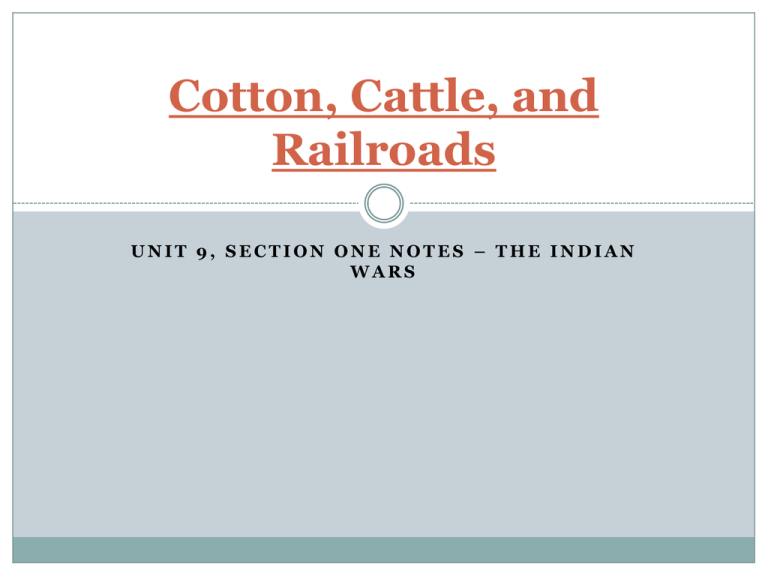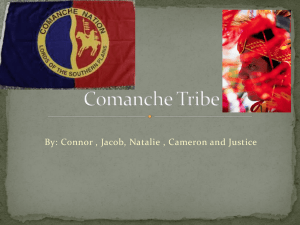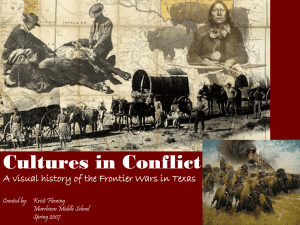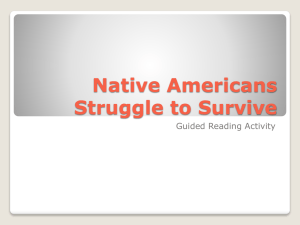Unit 9, Section One Notes
advertisement

Cotton, Cattle, and Railroads UNIT 9, SECTION ONE NOTES – THE INDIAN WARS Indians During the Civil War During the Civil War, the Plains Indians were able to easily attack settlements on the frontier because most Texas men had gone off to fight. Even when the war was over, there were not enough troops to protect the frontier settlements. In an effort to end violence, the U.S. government attempted to negotiate peace treaties with various Plains Indian groups. The Buffalo Soldiers After the Civil War in 1866, regiments of African American soldiers were formed. They were created to help keep peace among the Kiowa, Comanche, and other Native American tribes in the West. During the early years of their history, the buffalo soldiers served mainly in Kansas, Texas, and New Mexico. In 1885, several companies from the 9th Cavalry were detailed to Indian Territory to remove the white homesteaders who were trying to stake illegal claims on Indian lands. They are remembered for their bravery and valor. The Treaty of the Little Arkansas In 1865, government representatives were sent to negotiate a peace treaty with the Comanche and Kiowa. Both groups of Native Americans agreed to settle on a reservation in the Texas Panhandle, but the peace didn’t last because the U.S. never created the reservation. Both groups continued their attacks and many settlers moved back further east, away from the open frontier. Treaty of the Little Arkansas 1865 - Black Kettle Speaks By Bryan Haynes The Treaty of Medicine Lodge In 1867, the U.S. government sent officials to bargain a new treaty with Plains Indians at Medicine Lodge Creek, Kansas. The government representatives brought gifts and offered 3 million acres of land for a reservation, including building, farming tools, and money. Some of the Indian leaders were against the reservation, while others felt that it was the only way for the Native Americans to survive. Many Plains Indians agreed to the Treaty of Medicine Lodge and several thousands moved onto reservations known as Indian Territory. Native American Reactions Kiowa chief, Satanta, bitterly opposed the new treaty, arguing that the Panhandle belonged to the Kiowa and Comanche. He made a famous speech at the meeting – “I have heard that you intend to settle us on reservations near the mountains. I don’t want to settle. I love to roam over the prairies. There I feel free and happy, but when we settle down we grow pale and die…These soldiers cut down my timber; they kill my buffalo; and when I see that, my heart feels like bursting.” Satanta – Means White Bear The Peace Policy In 1869, President Ulysses S. Grant created a Board of Indian Commissioners to carry out the terms of the peace treaty. The board was created to teach the Plains Indians to make a living by farming and adjust to reservation life. Still, there were many problems with the reservation system. Though they wanted them to farm, the land they gave them had poor soil and they often starved for food and lacked basic supplies. Indian attacks continued. The Salt Creek Raid As the attacks continued, Texas officials began to complain to the federal government, and in 1871, General William Tecumseh Sherman was sent to investigate. Sherman did not think that the Indians were a threat until the Salt Creek Raid, in which 7 men were killed by Satanta and other Kiowa and Comanche leaders. The leaders of this attack were arrested, tried for murder, and sentenced to death, but many for the peace policy felt that if the men were hanged, it would make matters worse. Satanta was later released from prison for good behavior. Interestingly…. On May 17, 1871, the day before the Salt Creek Raid in North Texas, General Sherman was in a wagon on the way to Fort Richardson. Unknown to Sherman, a group of Kiowa and Comanche considered attacking the wagon train. Instead, decided to attack the next one that came along – and this would later be known as the Salt Creek Raid. Mackenzie’s Raiders In response to the Salt Creek Raids, the U.S. War Department sent out Colonel Ranald S. Mackenzie to attack Plains Indians who refused to live on the reservations. Mackenzie’s men became known as Mackenzie’s Raiders. They began their raids in 1871, attacking Comanche groups throughout the state. Eventually, many Comanche abandoned life on the plains and moved to the reservations. Cynthia and Quanah Parker Cynthia Parker was captured by the Comanche at the age of 10 and remained with the Comanche for almost 25 years. She married a Comanche man and had four children, including one son, Quanah Parker. Quanah became one of the most important Comanche leaders of his time. Cynthia was later captured by Texans and forced to live with her relatives, though she continued to see herself as Comanche. The Slaughter of the Buffalo Along with attacks by U.S. soldiers, Plains Indians were also being threatened by the slaughter of the buffalo. In the 1870’s, railroad companies began to kill buffalo to feed the rail crews. Then, the price of hides rose to three dollars a piece, sending many buffalo hunters into Texas. With buffalo guns, a good hunter could kill 75 to 100 buffalo a day. Millions Killed Buffalo hunters were not supposed to be allowed on Indian land, but many people in Texas welcomed them, thinking that killing the buffalo would force the Indians onto reservations. Between 1872 and 1874, hunters killed an estimated 4.3 million buffalo. The hunters often killed the buffalo, took the hides, and left the meat to rot. This outraged the Plains Indians. The Battle of Adobe Walls By the spring of 1874, the Plains Indians were starving on the reservations and desperate. In June of 1874, Quanah Parker led the Comanche, along with a group of Kiowa. They targeted the trading post at Adobe Walls in the Texas Panhandle. 700 Plains Indians attacked 28 men and one woman at the trading post. The people at the trading post had buffalo guns, and so could hold off the Native Americans. Still, the Plains Indians began a widespread war against buffalo hunters and settlers. Painting printed in a magazine in Texas in 1908 The Red River War After the battle, General Sherman was ordered to attack raiding Indians, to kill or remove remaining American Indians in the Panhandle. In August of 1874, the army began an offensive known as the Red River War. Many Texas Rangers joined the group, hoping to defend the frontier. The soldiers forced hundreds of Indians, mainly women and children, onto reservations. The Battle of Palo Duro Canyon Colonel Mackenzie and his raiders learned that there was a group of Plains Indians camping out in Palo Duro Canyon, east of Lubbock. Before dawn on September 28, 1874, Mackenzie and 500 troops surprised the Indian villages and killed three Comanche. Though few were killed, the battle took a terrible toll on the Comanche. The Indian group left behind most of their supplies when they fled, including 1,400 horses, which Mackenzie had shot. The Comanche were forced to move onto Indian Territory. The Indian Wars End in Texas After several other altercations between the U.S. Army and Plains Indians, most Texas Indians were moved onto reservations in what is now Oklahoma. They had to give up their traditional way of life – hunting buffalo – and take up farming. Their efforts often failed because the land they received was not suited for farming or ranching. They often faced starvation when the U.S. government did not provide them with food subsidies. Limited Rights Also, the federal government banned many Native American religious practices in 1883. Indians had to hold their celebrations in secret. Many Indian groups continued to speak in their own languages and tried to preserve their customs and styles of dress. Still, the U.S. government tried to limit these traditional aspects of the Indians’ lives. Quanah Parker After surrendering and moving onto reservations in 1875, Quanah Parker worked to improve Native American relations with the federal government and often went to Washington D.C. as an Indian representative. He tried to improve the lives of the Comanche through agreements until his death in 1911. Even though promises were made, much of the land promised to the Native Americans was later sold and American Indians were not granted full citizenship until 1924. The Effect on Native Americans The difficulties of reservation life, military attacks, and the slaughter of the buffalo took a toll on Texas Indians. By the 1880’s, their population in Texas had been greatly reduced and most had either been killed or moved out of the state. The land left behind was quickly filled by settlers looking to farm and ranch, though the Indians had called that land home for hundreds of years.











